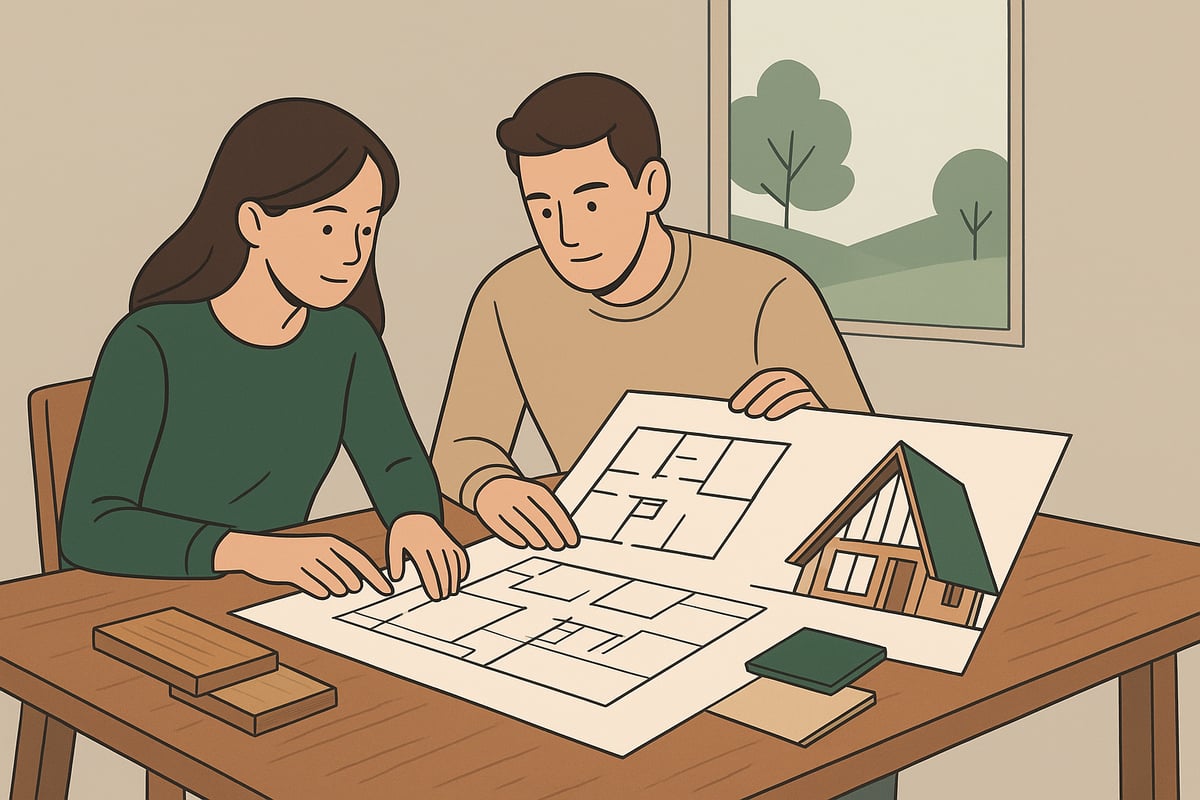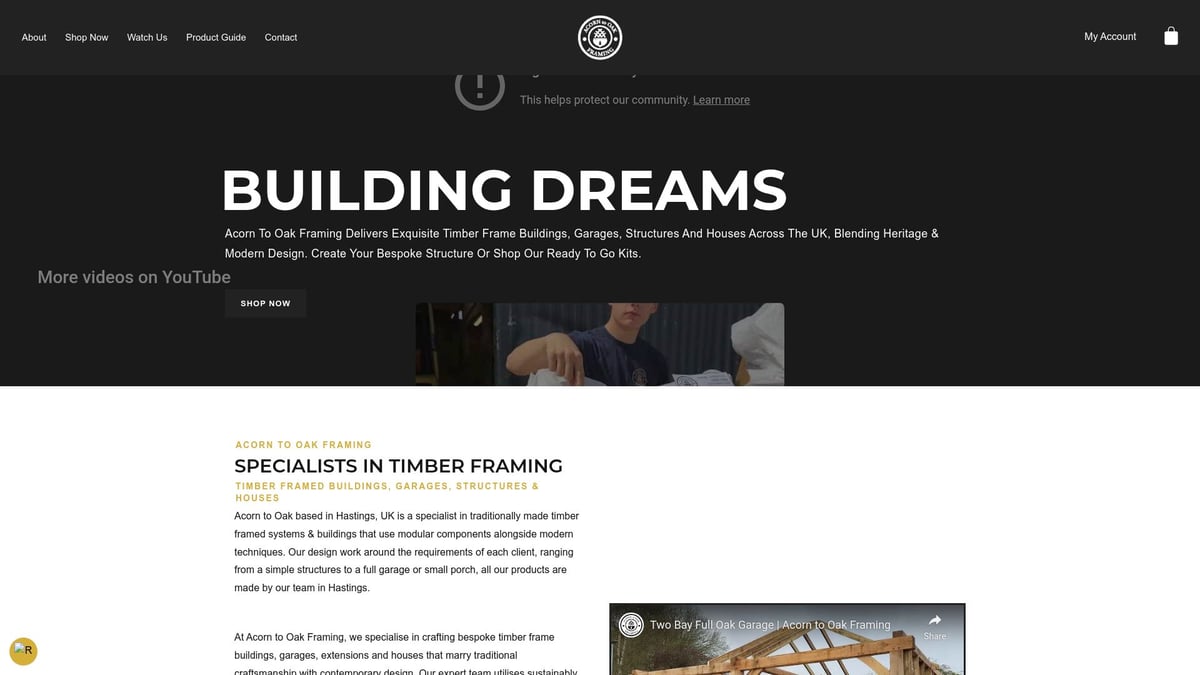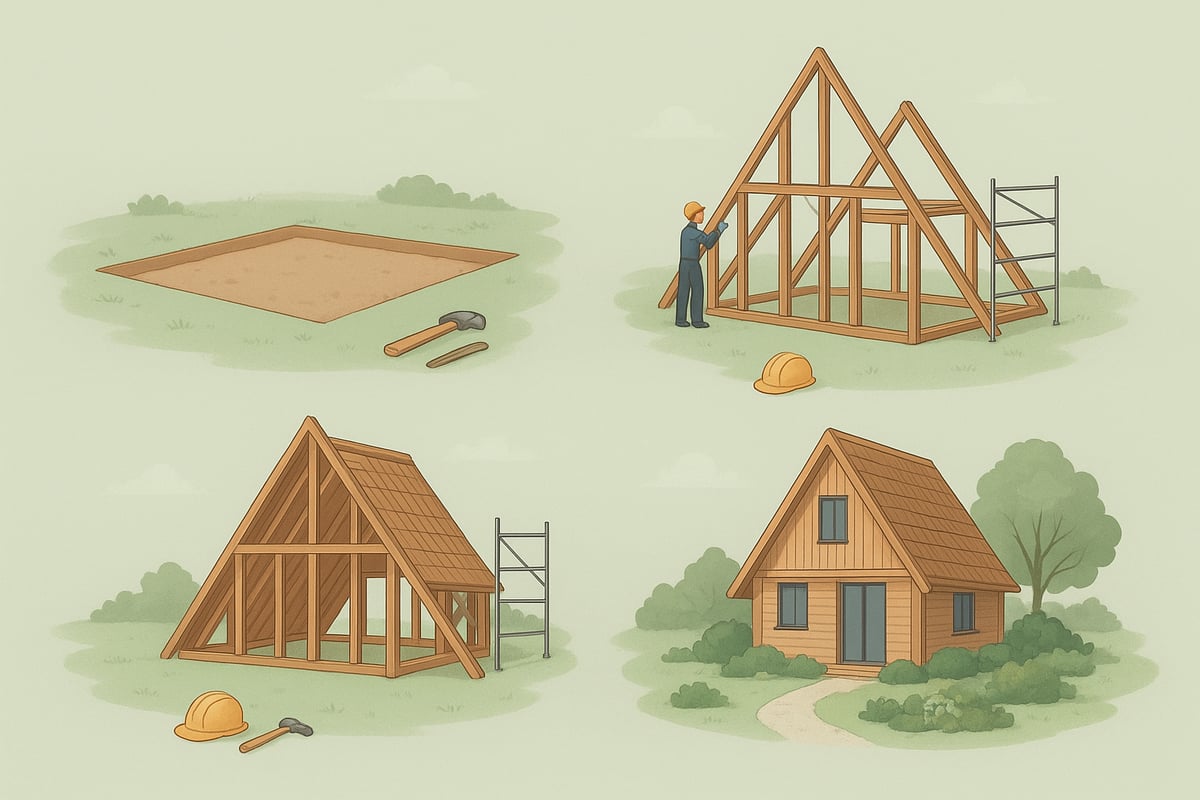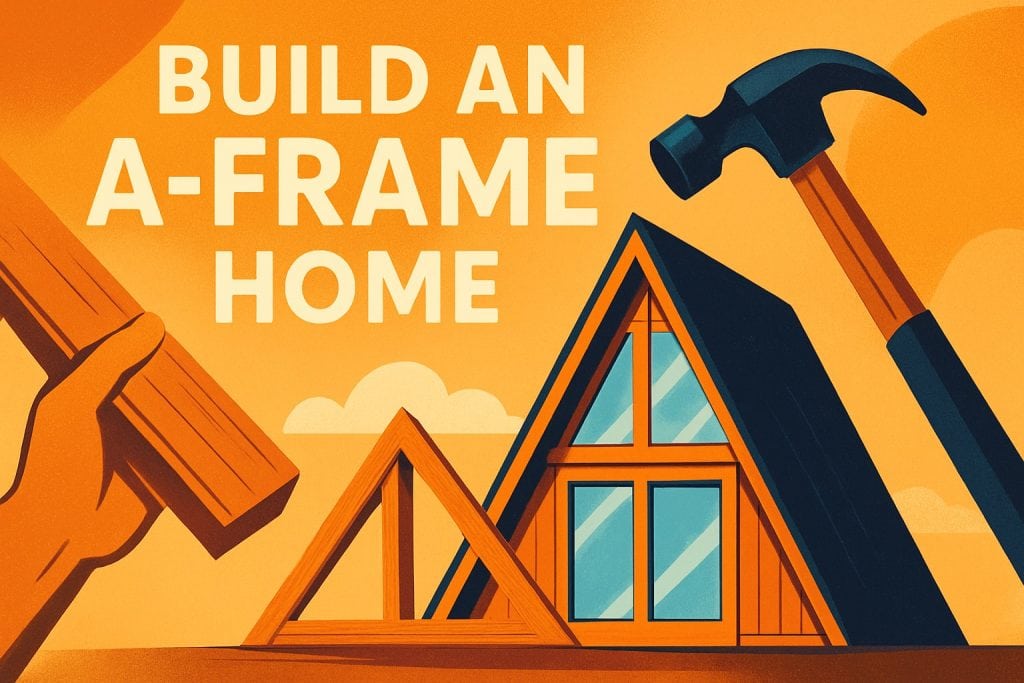The iconic A-frame home is making a striking comeback in 2025, capturing the imagination of those seeking both style and substance. With their distinctive silhouette and blend of modern efficiency with timeless design, these homes are turning heads across the UK.
This essential guide will walk you through every crucial step to build an a frame home, from the earliest planning decisions to the final finishing touches. Whether you are inspired by energy efficiency, unique architecture, or a desire for a sustainable lifestyle, you will find practical advice and up-to-date knowledge here.
Inside, you will discover expert tips on planning, budgeting, design innovation, building regulations, construction phases, and eco-friendly solutions. Ready to embark on your own A-frame journey? Let us show you how.
Understanding A-Frame Homes: Features, Benefits, and Trends
The A-frame home stands out for its iconic triangular silhouette, a design that has captured imaginations since its mid-century rise. Today, as more people look to build an a frame home, this style is evolving with modern touches and efficiency, making it one of the most compelling choices in 2025.

Defining the A-Frame: Distinctive Architecture and Appeal
A-frame homes trace their roots back to post-war Europe and North America, where architects valued simplicity and structural strength. The most recognisable feature is the steeply angled roof, which forms both the walls and the roof in a single, continuous line. This clever geometry allows snow and rain to slide off easily, a practical benefit that endures.
Key architectural elements include:
- Expansive, open-plan interiors with minimal internal walls
- Large floor-to-ceiling windows that flood spaces with light
- Lofted spaces or mezzanines for extra living or sleeping areas
In 2025, homeowners increasingly choose to build an a frame home with innovative materials, energy-efficient glazing, and flexible layouts. Compared to traditional timber frame and modular homes, A-frames offer a unique blend of style and utility.
| Feature | A-Frame Home | Traditional Timber Frame | Modular Home |
|---|---|---|---|
| Roof Shape | Steep Triangle | Gable or Hip | Flat or Varied |
| Interior Layout | Open, Lofted | Partitioned | Customisable |
| Energy Efficiency | High (with upgrades) | Moderate | High |
| Build Speed | Fast (kits possible) | Moderate | Fast |
| Cost | Moderate | Moderate to High | Variable |
Recent years have seen a surge in A-frame builds across the UK and internationally. According to industry data, the number of planning applications to build an a frame home in the UK has doubled since 2020. The appeal lies in energy efficiency, cost-effectiveness, and the ability to customise the design. However, there are some drawbacks to consider, such as limited wall space for storage and the challenge of insulating the steep roof. For a deeper dive into design features and construction innovations, see the Timber Frame A-Frame House Guide.
Why Build an A-Frame Home in 2025?
The drive to build an a frame home is stronger than ever in 2025, fuelled by demand for sustainable and visually striking housing. A-frames lend themselves naturally to eco-friendly living, with designs that maximise natural light and reduce energy consumption.
For self-builders, A-frames offer flexibility. They are ideal as holiday lets, family homes, or creative retreats. The resale value is also strong, especially as buyers seek out sustainable, characterful properties.
A-frame construction supports a range of green technologies, from solar panels to heat pumps, helping homeowners exceed new UK energy regulations. These homes are often easier and quicker to assemble than conventional builds, with many suppliers offering ready-to-assemble kits.
There are many successful examples of people who build an a frame home in the UK, from rural escapes in the Lake District to contemporary coastal retreats. These projects demonstrate the enduring appeal and versatility of this design.
Choosing to build an a frame home in 2025 means embracing a lifestyle that is both modern and timeless, efficient and expressive.
Planning Your A-Frame Home Project
Embarking on the journey to build an a frame home starts with careful planning. Laying a strong foundation in the early stages will save you time, money, and stress later on. This section guides you through setting clear goals, selecting the perfect plot, and managing your budget—essential steps for any successful a frame project.

Setting Your Vision and Goals
To build an a frame home that truly suits your lifestyle, begin by identifying your core needs. Will your A-frame be a cosy retreat, a full-time residence, or a holiday let? Think about the ideal size, number of bedrooms, open-plan living spaces, and whether you want features like a loft or a mezzanine.
Seek inspiration from design magazines, online galleries, and recent trends shaping A-frame homes in 2025. Visualising your dream space will help you communicate requirements to architects or kit suppliers.
Set realistic expectations for both budget and timeline. A typical UK A-frame project can take 9–15 months from conception to completion, depending on complexity and weather. For clarity, here’s a sample budget breakdown from a recent UK build:
| Item | Estimated Cost (£) |
|---|---|
| Land Purchase | 70,000 |
| Design & Planning | 9,000 |
| Materials | 68,000 |
| Labour | 52,000 |
| Contingency | 15,000 |
| Total | 214,000 |
Careful planning at this stage helps ensure your build an a frame home journey remains enjoyable and predictable.
Choosing the Right Plot and Location
Location is critical when you build an a frame home, as it affects light, views, access, and future value. Prioritise orientation—south-facing plots maximise natural light and energy efficiency. Check access for construction vehicles and eventual residents.
Securing planning permission is essential. Research land costs and availability in your preferred region. Consult local council websites for zoning restrictions and application procedures. Be prepared to submit detailed site plans and environmental surveys. For guidance on compliance and structural safety, refer to the UK Building Regulations for A-Frame Homes.
Environmental considerations play a vital role. Evaluate flood risks, soil types, and wind exposure. These factors influence foundation choices and long-term durability.
Always visit potential plots in person. Walk the land, imagine your future home, and assess the surroundings. A well-chosen site will make it easier to build an a frame home that stands the test of time.
Budgeting and Financing Your Build
Budgeting is one of the most important steps when you build an a frame home. Begin by estimating total costs, including design, materials, labour, planning fees, and a contingency fund. Research current prices for timber and specialist trades in your area.
Explore funding options:
- Self-funding or savings
- Specialist self-build mortgages
- Government grants for eco-friendly homes
To save money, weigh up DIY tasks versus hiring professionals. Sourcing materials locally and choosing kit homes can reduce costs. Here’s a comparison:
| Approach | Average Cost (£) | Timeframe |
|---|---|---|
| Kit Home | 160,000 | 6–10 months |
| Bespoke Build | 210,000+ | 10–15 months |
Factor in hidden costs like site access, utility connections, and possible delays. With a clear financial plan, you can confidently build an a frame home that meets your vision and budget.
Designing Your A-Frame Home: Plans, Layouts, and Customisation
Designing how you build an a frame home is where vision meets practicality. Every choice, from layout to materials, shapes not just the look but also the comfort, efficiency, and sustainability of your new space.
Creating the Perfect Floor Plan
A thoughtful floor plan is essential when you build an a frame home. Open-plan living is a hallmark of A-frame architecture, making even compact interiors feel spacious.
Consider the number of bedrooms and bathrooms needed for your lifestyle. Lofts and mezzanines can add sleeping or storage space, but keep in mind the roof angle can limit headroom. Smart storage solutions, such as built-in cabinetry under the eaves, maximise every inch.
Outdoor living is another key feature. Connect your interior with decks, balconies, or even a garden room to blur boundaries between inside and out. For accessibility, plan wider doorways and minimal steps to future-proof your home.
Materials and Structural Choices
Material selection is crucial as you build an a frame home. Timber framing, especially oak, remains a popular choice in the UK for its strength and timeless appeal. Pine and engineered wood offer budget-friendly alternatives. Modern options like steel or SIPs (Structural Insulated Panels) provide extra insulation and design flexibility.
For more insight into timber frame options and their impact on UK homebuilding, see Oak Framed Homes in the UK.
Insulation is vital to meet 2025 standards. Choose high-performance glazing for windows and skylights to boost natural light while maintaining thermal efficiency. These decisions will define your home's comfort and long-term energy savings.
Sustainability and Eco-Friendly Design
Sustainability is front and centre when you build an a frame home today. Prioritise low-impact materials, such as FSC-certified timber and recycled insulation.
Integrate renewable energy: solar panels, heat pumps, and rainwater harvesting can all reduce your carbon footprint. Use passive design principles—orient your home to capture sunlight, and choose window placements that promote natural ventilation.
Ensure your plans comply with the latest UK regulations for eco homes. This proactive approach not only lowers running costs but also protects future resale value.
Working with Professionals vs. DIY Design
When you build an a frame home, you must decide between professional support and a self-designed approach. Architects and designers bring expertise, ensuring your plans meet building codes and maximise space. They can also help navigate planning permissions.
DIY design is more accessible than ever, with online tools and A-frame kits simplifying the process. However, self-design can be time-consuming and may risk costly mistakes. Weigh the pros and cons carefully:
- Professional: higher upfront cost, lower risk, tailored solutions.
- DIY: budget-friendly, greater control, more learning required.
Consider your skills, budget, and timeline before choosing your path.
Acorn to Oak Framing: Expert Timber Frame Solutions
If you want to build an a frame home with timeless style and cutting-edge performance, Acorn to Oak Framing stands out as a UK leader in bespoke timber frame buildings. Their traditional craftsmanship blends seamlessly with modern design, ensuring your home meets all UK standards.

Services include custom design, ready-to-assemble kits, and full project support. Case studies show successful A-frame builds across the country, each with unique character.
Sustainability is at the heart of their approach. They use responsibly sourced oak and eco-friendly practices, helping you build an a frame home that is both beautiful and future-ready.
Step-by-Step Guide to Building Your A-Frame Home
Building an A-frame home in 2025 is a rewarding journey, but success relies on careful planning and execution at every stage. This guide breaks down the process into clear, actionable steps, helping you confidently build an a frame home in the UK.

Step 1: Securing Planning Permission and Meeting Regulations
The first step to build an a frame home is securing planning permission from your local council. You must submit detailed site plans, architectural drawings, and supporting documents. These should demonstrate how your design fits within local policies, addresses environmental concerns, and meets visual impact standards.
In the UK, building regulations are equally crucial. They govern insulation, fire safety, structural integrity, and accessibility. For timber frame structures, review the NHBC Standards for Timber Frame Construction to ensure compliance. Missing details or incorrect paperwork can cause significant delays.
Prepare your application with care. Double-check requirements for ecological surveys or flood risk assessments if your plot is sensitive. Early engagement with planning officers often helps pre-empt objections, smoothing the way as you build an a frame home.
Step 2: Preparing the Site and Foundations
Once permissions are secured, site preparation begins. Clearing vegetation, levelling the ground, and arranging access for vehicles are vital. A soil survey helps determine the best foundation type for your project.
Common choices for A-frame homes include slab, pier, or crawl space foundations. Each has pros and cons, so compare costs and suitability for your ground conditions. Proper drainage is essential to prevent future problems. Laying utilities like water and electricity at this stage avoids costly retrofits.
A typical UK site might require several weeks for groundworks, depending on weather and complexity. Careful planning and a clear schedule reduce risks and keep your build an a frame home project on track.
Step 3: Framing and Structural Assembly
With the site ready, the main structure takes shape. Erecting the A-frame involves assembling prefabricated trusses or constructing the frame on-site. Timber quality, treatment, and proper bracing are vital for long-term durability and safety.
Follow a strict sequence: set the base, raise the main frame, fix roof trusses, and install wall panels. Prioritise weatherproofing as you go, using tarpaulins or temporary cladding if rain threatens. For a comprehensive look at this phase, see the Frame Home Construction Process.
Building teams should follow all safety protocols, using scaffolding and protective equipment. Accurate assembly at this stage is crucial to avoid costly corrections later. Each element must align perfectly, ensuring your build an a frame home project will pass inspections and stand the test of time.
Step 4: Roofing, Windows, and External Finishes
The next stage is enclosing your home. Choose roofing materials like metal panels, shingles, or even living green roofs for sustainability. Install large windows and skylights to maximise natural light, a hallmark of A-frame design.
Cladding options include timber, composite, or recycled materials. Ensure each is fitted with care to prevent leaks and minimise maintenance. Gutters and external drainage protect your structure from water damage.
Attention to detail at this stage not only enhances appearance but also improves energy efficiency. Quality finishes add value and longevity, making your efforts to build an a frame home worthwhile.
Step 5: Internal Fit-Out and Systems
Now focus shifts to the interior. Modern A-frame homes must meet strict insulation and airtightness standards, especially for 2025 regulations. Install electrical wiring, plumbing, and heating systems before closing up walls.
Flooring, wall finishes, and ceilings follow, allowing for your chosen style—whether minimalist or rustic. Consider integrating smart home features, such as programmable thermostats or security systems, for comfort and convenience.
Careful sequencing of trades prevents delays and costly rework. Each decision in this phase shapes the comfort, efficiency, and style of the final build an a frame home project.
Step 6: Landscaping and Outdoor Spaces
The final step is enhancing your outdoor environment. Decking, patios, and garden design extend living space and connect your home to its surroundings. Plan driveways and paths for easy access and safety.
Incorporate outdoor lighting and security features for peace of mind. Choose native plants for low-maintenance, eco-friendly gardens. These finishing touches transform your project, making it a true retreat.
Regular maintenance and thoughtful upgrades will keep your home looking fresh. With every stage complete, you can enjoy the lifestyle and satisfaction that come when you build an a frame home in the UK.
Costs, Timelines, and Project Management
Building an A-frame home in the UK requires careful planning around costs, timelines, and project management. Knowing what to expect financially and logistically will help you avoid surprises and keep your dream project on track.
Breaking Down the Costs
Understanding the full financial landscape is crucial when you build an a frame home. Costs typically fall into several categories: design, materials, labour, permits, site preparation, and contingency funds. In 2024-2025, the average cost to build an a frame home in the UK ranges from £1,800 to £2,500 per square metre, depending on location and specification.
Typical Cost Breakdown Table
| Item | Percentage of Total Cost | Example (£250,000 build) |
|---|---|---|
| Materials | 35% | £87,500 |
| Labour | 30% | £75,000 |
| Design/Professional | 10% | £25,000 |
| Permits/Fees | 5% | £12,500 |
| Site Prep/Utilities | 10% | £25,000 |
| Contingency | 10% | £25,000 |
Hidden costs can arise from site access, connecting utilities, or unexpected groundworks. Always allocate at least 10% of your budget for unforeseen expenses. For those aiming to meet the Future Homes Standard 2025 Overview, expect extra investment in insulation and renewable energy systems.
Managing Your Build Timeline
A well-structured timeline is essential when you build an a frame home. Most projects take between 8 to 14 months from initial design to completion. The timeline includes design and approvals (2–4 months), site preparation (1 month), construction (4–8 months), and final fit-out (1–2 months).
Key factors influencing timelines:
- Planning permission and regulatory approvals
- Weather and seasonal conditions
- Material lead times and supply chain disruptions
- Skilled labour availability
A Gantt chart is an effective tool for tracking milestones and dependencies. Regularly update your schedule and communicate with your team to prevent delays. Delays often occur due to late material deliveries or changes in design, so being proactive is vital.
Choosing Your Build Route: Self-Build vs. Turnkey
Selecting your build route is a major decision for anyone looking to build an a frame home. The self-build approach offers maximum control and potential cost savings, but demands significant time and project management skills. Kit homes simplify construction and can speed up timelines, while turnkey solutions provide a hassle-free experience but at a premium.
Comparison Table
| Approach | Pros | Cons |
|---|---|---|
| Self-Build | Control, potential savings | Time-consuming, higher risk |
| Kit Home | Faster, predictable costs | Limited customisation |
| Turnkey | Stress-free, professional management | Higher cost, less flexibility |
New technologies are influencing build options. For example, Timber and Robotics in UK Housing explores how robotics and prefabrication are reducing construction times and enhancing quality for timber-framed homes.
Avoiding Common Pitfalls and Delays
To successfully build an a frame home, learning from others' experiences is invaluable. Common pitfalls include underestimating costs, poor site access planning, and communication breakdowns with contractors.
Tips to avoid delays:
- Double-check all planning documents and permissions before starting
- Schedule regular site meetings and progress checks
- Keep detailed records of decisions and changes
- Invest in snagging and thorough quality control before handover
Quality assurance and clear communication are your best defences against costly mistakes. By planning ahead and staying organised, you can enjoy a smooth process and a beautiful, bespoke home.
Living in Your A-Frame Home: Maintenance, Upgrades, and Lifestyle
Building an A-frame home is only the beginning. Maintaining, upgrading, and truly living in your unique space require ongoing attention. Embracing the lifestyle, caring for your investment, and planning for the future will ensure your home remains comfortable, valuable, and a joy to inhabit for years to come.
Day-to-Day Maintenance and Care
Proper care is essential once you build an a frame home. Routine checks help preserve both the beauty and structural integrity of your property. Inspect the roof and timber for weathering, as steep angles can collect debris or snow. Clean large windows regularly to maximise light and maintain clear views.
Good ventilation is crucial. Use trickle vents or openable skylights to manage condensation, especially in high-ceiling spaces. Monitor energy use, as efficient insulation is vital for comfort and low bills.
A simple maintenance checklist:
- Inspect roof and gutters every season
- Clean windows and frames monthly
- Treat exposed timber annually
- Check seals and insulation
By staying proactive, you protect your investment and enjoy peace of mind.
Upgrades and Future-Proofing
When you build an a frame home, consider how your needs may change. Upgrading with extensions or outbuildings can add valuable space for guests or hobbies. Adding solar panels or a heat pump helps future-proof your home against rising energy costs.
Smart home technology is increasingly popular. Retrofitting automated lighting, security, or heating systems can enhance convenience and efficiency. Plan for family growth by designing flexible interiors or modular furniture that adapts with you.
Popular upgrades:
- Solar panel installation
- Loft conversions for added bedrooms
- Smart thermostats and lighting
- Garden studios or home offices
Thoughtful upgrades ensure your home evolves with your lifestyle.
Embracing the A-Frame Lifestyle
To fully enjoy your decision to build an a frame home, embrace its unique design. Open-plan layouts and high ceilings invite creativity in decorating. Trends for 2025 include minimalist Scandinavian palettes, rustic timber accents, and biophilic touches like indoor plants.
Large windows flood interiors with natural light, creating uplifting spaces. Outdoor living is an extension of the home; decks and balconies become social hubs. Many owners join A-frame communities or online groups to exchange ideas and inspiration.
For more on modern approaches, explore Contemporary Timber Frame Houses Trends to discover the latest styles and innovations in timber frame living.
Maximising Value and Resale Potential
Maintaining and upgrading when you build an a frame home directly impacts its market value. Staging your property with neutral tones and uncluttered spaces helps buyers imagine themselves living there. Highlight energy-efficient features, unique architecture, and flexible layouts.
The UK market increasingly values sustainable and distinctive homes. Recent data shows A-frame properties often attract strong interest and competitive offers, especially when well maintained.
Tips for boosting resale value:
- Keep interiors bright and fresh
- Document all upgrades and energy improvements
- Present outdoor areas as additional living space
With careful planning, your A-frame home can deliver both lifestyle rewards and long-term financial return.
With everything you have learned about planning, designing, and building an A frame home, you are now equipped to turn your dream project into a reality. Working with a specialist like Acorn to Oak Framing means you benefit from traditional craftsmanship, modern design, and a personal approach that ensures your new home is as unique and sustainable as you imagine. If you are ready to take the next step and bring your bespoke A frame vision to life, let us help guide you through every stage of the journey.
BUILD NOW












